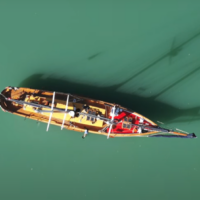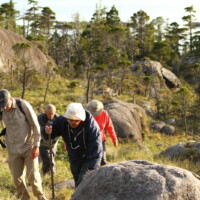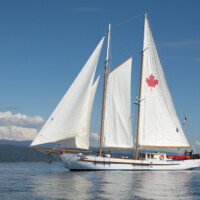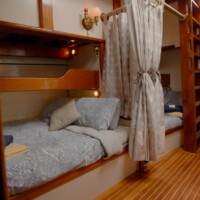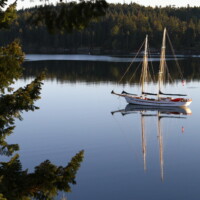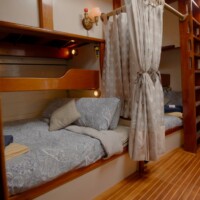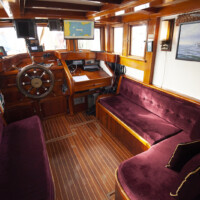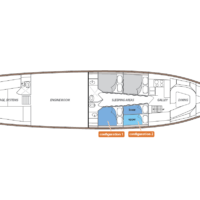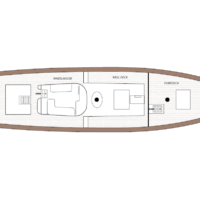92-Foot Schooner
Maple Leaf is a classic, 92-foot schooner. She accommodates up to 8 guests in 4 semi-private sleeping areas, with a crew of 4 or 5.
Outfitted for Engaging with the Natural World
Maple Leaf is a classic, 92-foot schooner. She accommodates up to 8 guests in 4 semi-private sleeping areas, with 3 shared washrooms, and a crew of 4 or 5.
Maple Leaf is a sea-kindly vessel with a long range. She can take you to the coast’s wildest, remotest corners more comfortably and safely than most other vessels. Her sails and 40,000-pound keel keep her steady, and her crew’s warmth and culinary delights keep your soul soaring.
You have access to sites, phenomena and people you cannot get on larger ships, often unable to access the special areas we take you. What’s more, you have access to this in a very personalized, human-scale manner.
Maple Leaf, BC’s historic tall ship, was built in 1904 by William Watts in Vancouver Shipyard. Initially a private yacht for Alexander Maclaren, she boasted the title of the most expensive pleasure craft on the Pacific Coast and was the first ship north of San Francisco with electric lights and an external lead keel.
She was favoured to win the first ever Trans Pacific sailing race from San Francisco in 1906. But when the San Fransisco earthquake devestated the city, the race was postponed and move to LA and the Maple Leaf never participated. So we will never know if she had been fated to become the Bluenose of the Pacific.
During the First World War, her lead keel and brass were stripped for the war effort, leading to her conversion into a halibut fishing vessel. For two decades, she fished under famous fishing companies such as Gosse and Millerd and the Canadian Fishing Company.
Purchased by Harold Helland in 1938, Maple Leaf, renamed Parma, was completely rebuilt during World War II. Harold, along with a dedicated crew, fished for halibut in the treacherous Bering Sea until the mid-1970s, consistently surpassing newer vessels in performance. Harold maintained his ship in Bristol condition until his retirement in 1978, when she was sold to the Canadian Government.
In 1980, Brian Falconer and Susan Tweedie restored Maple Leaf to a sailing ship, uncovering her original hull lines and re-registering her. From 1986 to August 2001, Brian, Susan, and later Brian with partner Erin Nyhan, operated Maple Leaf Adventures, providing natural history and cultural trips along the BC and Alaska coasts. They also ran the Tall Ship Program for the Royal Canadian Sea Cadets, training over 3,000 cadets from across Canada.
Since 2001, Kevin Smith has led Maple Leaf Adventures, garnering recognition from National Geographic, Outside magazine, and winning awards for sustainable tourism. Kevin and Maple Leaf have continued her tradition of helping to protect the places of the coast, including bringing places like the Great Bear Rainforest to international media audiences. The ship continues to be meticulously maintained, drawing admiration at tall ship festivals.
Maple Leaf: A Timeline
- 1904: The Coast’s Most Expensive Yacht
- 1914: The War Changes Maple Leaf’s Fate
- 1938: Fishing For Halibut In The Bering Sea
- 1980: Maple Leaf Sails Again
